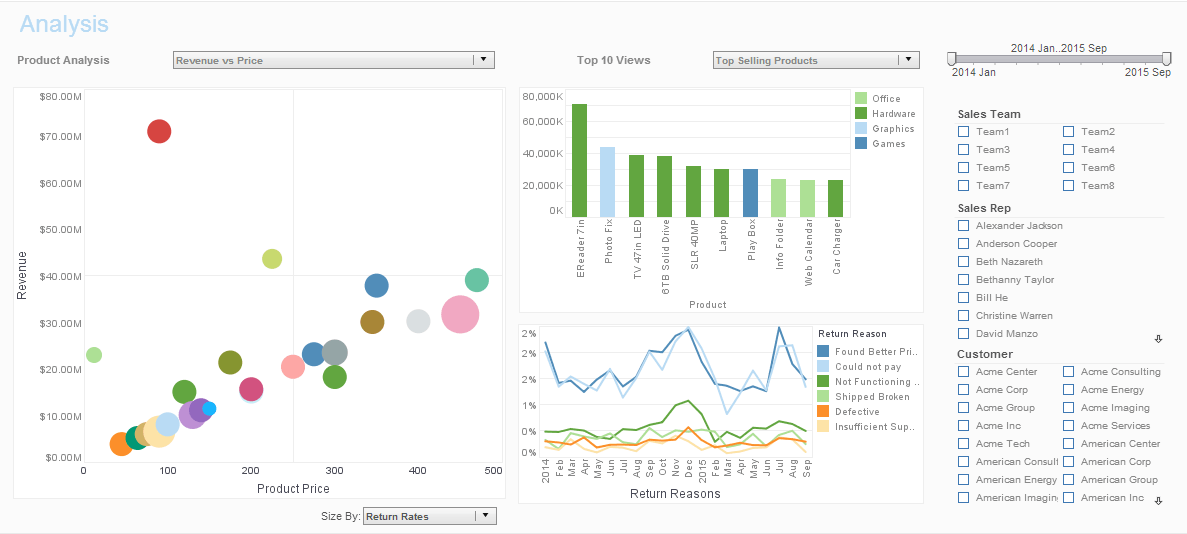InetSoft Webinar: Case Study of Event Marketing Analytics
This is the continuation of the transcript of a Webinar hosted by InetSoft on the topic of "How to Implement Business Analytics." The speaker is Abhishek Gupta, product manager at InetSoft.
Let me give you an example of event marketing analytics. When you’re planning big conferences you want to understand how many people are registered from what industry and what type of programs. Do you have content to meet all of their needs? So you have a data scientist or a data analyst bring together this information with a BI tool.
It’s a massive amount of data from many sources, and you bring it together, data from registrations, from Twitter about what’s the sentiment of the event, historical information on past events to understand what was successful in the past. You mash it together. The questions that your CMO asks are very different than the questions of the event planner who was setting up the event.
| #1 Ranking: Read how InetSoft was rated #1 for user adoption in G2's user survey-based index | Read More |
The operations people also use that data, but they ask very different questions, and they manipulate that data in very different visualizations. And that’s what I’m talking about. That needs to happen in the future, because the reality is not only do people get involved in data more than they ever have before, but also people’s needs in terms of what they do with data has changed.
So, I ask you all to consider this. Do not just assume that how people use data today will be the same as they do tomorrow. Think about how people use data in their personal lives and what's the ideal way that people are wanting to use data, whether it's to explore questions, whether it's to monitor. A lot of times it's to predict what's going to happen.
It used to be data scientists in backrooms were the ones predicting. But the reality is that is not a way to maintain a business. You have to get the predictive capabilities in the form that is very easy and intuitive for the outer edges of your company: that inventory manager, store manager, a maintenance guy that’s managing a plane that’s got maintenance issues. Everyone needs to predict what's happening next in their business. It can't be a data scientist in the backroom.
So you need to think about these things when you’re trying to figure out the right data, when you’re trying to figure out the right analytical tools for the individual. So this is what we mean by engraining insights into the DNA of your people and processes. How do you make sure that every individual has what they need, and it might change throughout the day. They may need to explore the data to get the answer.
They may need to monitor operational performance. You can design the perfect dashboard and get it out through your entire organization or even give it to your consumers. You need to be able to consider visualization. We never considered visualization as much as we do now. The reality is it is important when it comes to analytics.
 |
View a 2-minute demonstration of InetSoft's easy, agile, and robust BI software. |
If you are going to get the right information to your people, whatever your view is, it’s much more about how it’s seen and what that experience is. And then how can you derive unique insights that are going to be important to that person to run their business in real time and not have to sift through a billion records in a non intuitive way but actually have insight to jump out at them.
When they are placing a customer order, they should be able to see if customer has good credit history and what that customer is worth. Then they can know before placing that order that they will pay in the future. The BI applications need to have the right use cases for the specific industry or lines of business. Use cases will not only bring the analytics to the needs of the people but do it in a way that’s very industry specific and very line of business specific.
That way it meets the needs of those people, whether it’s predictive maintenance or fraud detection, predicting customer behavior or demand in your operations and supply chain. All of those analytics need to be wrapped up in a way that meet the needs of those organizations.
So and then you need to change your culture. You have to be a culture of that embraces information in real time, one that absolutely expects people to come in with their iPad. In a live meeting around the conference room everyone shares information in real time to get answers. One example I’d love to give is this huge multinational. They have over 45,000 analytic users, and they use mobile for most of those. They have eight lines of business.
| Previous: Case Study About Using Analytics to Perform Better |
